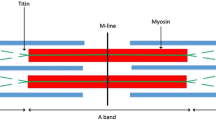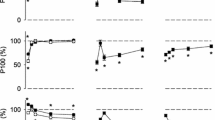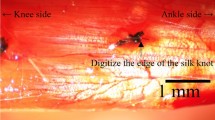Abstract
Following a series of eccentric contractions, that is stretching of the muscle while generating active tension, the length-tension relationship of isolated amphibian muscle has been shown to shift towards longer muscle lengths (Katz 1939; Wood et al. 1993). Here we report observations of electrically stimulated ankle extensor muscles of nine human subjects, demonstrating a similar shift in optimum angle for torque generation [3.9 (1.5)°] following exercise on an inclined treadmill that involved eccentric contractions in one leg. (All values are means with the SEMs in parentheses.) The shift in the unexercised, control leg was significantly less [mean 0.4 (0.7)°P < 0.05]. Correlated with this shift was a drop in torque [25.1 (5.6)% for the experimental leg; 1.6 (0.7)% for the control leg, P < 0.002]. Optimum angles returned to pre-exercise values by 2 days post-exercise, while torque took a week to recover. A similar shift in optimum length [12 (1.3)% of rest length] was obtained for five toad (Bufo marinus) sartorius muscles subjected to 25 eccentric contractions. Isometrically contracted control muscles showed a smaller shift [3.5 (1.6)%, n = 5]. Accompanying the shift was a drop in tension of 46 (3)% after the eccentric contractions [control isometric, 23 (6)%, P < 0.0001]. By 5 h after the eccentric contractions the shift had returned to control values, while tension had not recovered. When viewed with an electron microscope, sartorius muscles fixed immediately after the eccentric contractions exhibited many small, and a few larger, regions of myofilament disruption. In muscles fixed 5 h after the contractions, no small regions of disruption were visible, and the number of large regions was no greater than in those muscles fixed immediately after the eccentric contractions. These disruptions are interpreted as the cause of the shift in length-tension relationship.
Similar content being viewed by others
Author information
Authors and Affiliations
Additional information
Accepted: 9 January 1997
Rights and permissions
About this article
Cite this article
Jones, C., Allen, T., Talbot, J. et al. Changes in the mechanical properties of human and amphibian muscle after eccentric exercise. Eur J Appl Physiol 76, 21–31 (1997). https://doi.org/10.1007/s004210050208
Issue Date:
DOI: https://doi.org/10.1007/s004210050208




